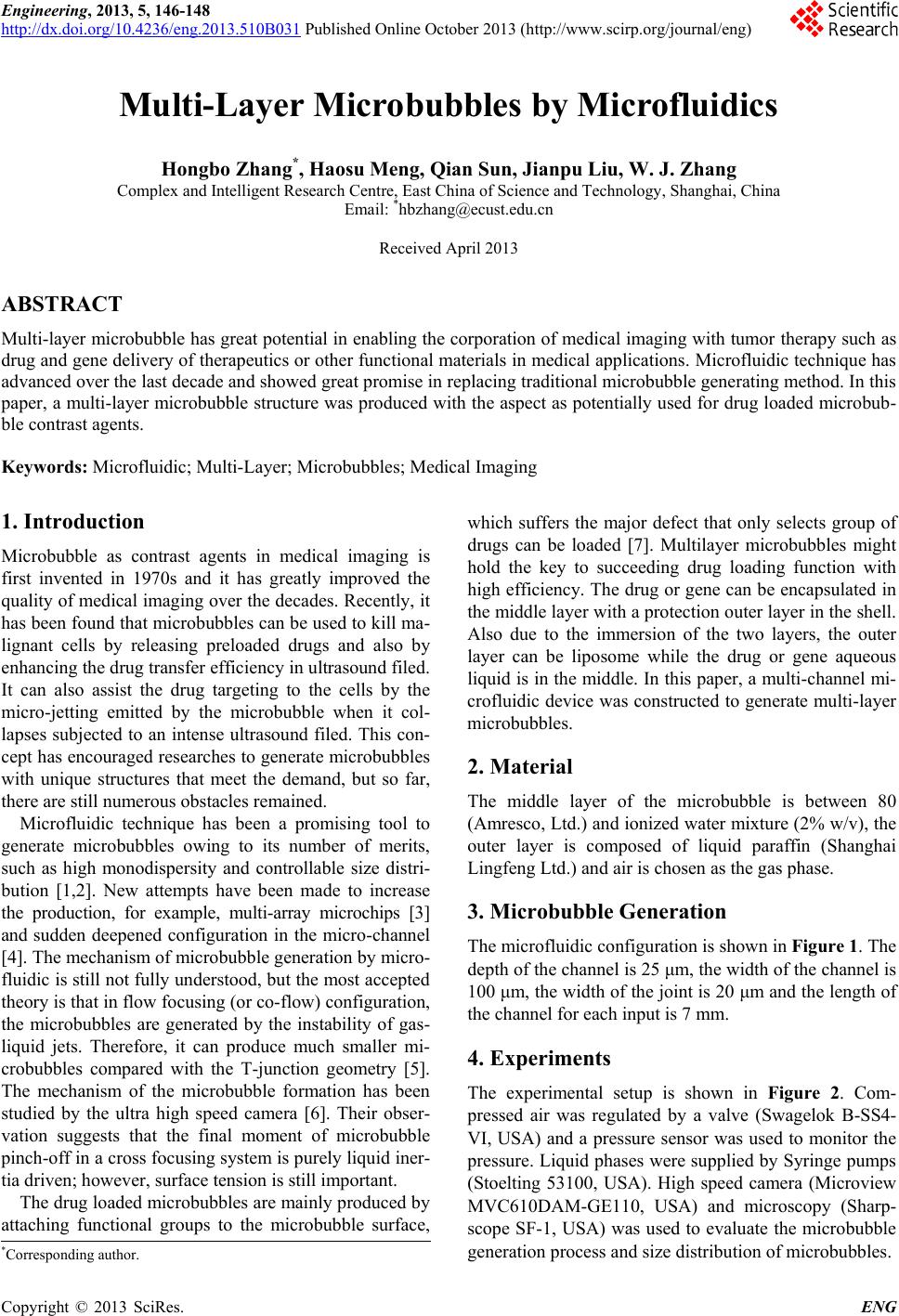
Engineering, 2013, 5, 146-148
http://dx.doi.org/10.4236/eng.2013.510B031 Published Online October 2013 (http://www.scirp.org/journal/eng)
Copyright © 2013 SciRes. ENG
Multi-Layer Microbubbles by Microfluidics
Hongbo Zhang*, Haosu Meng, Qian Sun, Jianpu Liu, W. J. Zhang
Complex and Intelligent Research Centre, East China of Science and Technology, Shanghai, China
Email: *hbzhang@ecust.edu.cn
Received April 2013
ABSTRACT
Multi-layer microbubble has great potential in enabling the corporation of medical imaging with tumor therapy such as
drug and gene delivery of therapeutics or other functional materials in medical applications. Microfluidic technique has
advanced over the last decade and showed great promise in replacing traditional microbubble generating method. In this
paper, a multi-layer microbubble structure was produced with the aspect as potentially used for drug loaded microbub-
ble contrast agents.
Keywords: Microfluidic; Multi-Layer; Microbubbles; Medical Imaging
1. Introduction
Microbubble as contrast agents in medical imaging is
first invented in 1970s and it has greatly improved the
quality of medical imaging over the decades. Recently, it
has been found that microbubbles can be used to kill ma-
lignant cells by releasing preloaded drugs and also by
enhancing the drug transfer efficiency in ultrasound filed.
It can also assist the drug targeting to the cells by the
micro-jetting emitted by the microbubble when it col-
lapses subjected to an intense ultrasound filed. This con-
cept has encouraged researches to gener ate microbubbles
with unique structures that meet the demand, but so far,
there are still numerous obstacles remained.
Microfluidic technique has been a promising tool to
generate microbubbles owing to its number of merits,
such as high monodispersity and controllable size distri-
bution [1,2]. New attempts have been made to increase
the production, for example, multi-array microchips [3]
and sudden deepened configuration in the micro-channel
[4]. The mechanism of microbubble generation by micro -
fluidic is still not fully understood, but the most accepted
theory is that in flow focusing (or co-flow) configuration,
the microbubbles are generated by the instability of gas-
liquid jets. Therefore, it can produce much smaller mi-
crobubbles compared with the T-junction geometry [5].
The mechanism of the microbubble formation has been
studied by the ultra high speed camera [6]. Their obser-
vation suggests that the final moment of microbubble
pinch-off in a cross focusing system is purely liquid iner-
tia driven; however, surface tension is still important.
The drug loaded microbubbles are mainly produced by
attaching functional groups to the microbubble surface,
which suffers the major defect that only selects group of
drugs can be loaded [7]. Multilayer microbubbles might
hold the key to succeeding drug loading function with
high efficiency. The drug or gene can be encapsulated in
the middle layer with a protection ou ter layer in the shell.
Also due to the i mmer si on of the two layers, the outer
layer can be liposome while the drug or gene aqueous
liquid is in the middle. In this paper, a multi-channel mi-
crofluidic device was constructed to generate multi-layer
microbubbles.
2. Material
The middle layer of the microbubble is between 80
(Amresco, Ltd.) and ionized water mixture (2% w/v), the
outer layer is composed of liquid paraffin (Shanghai
Lingfen g L t d.) and air is chosen as the gas phase.
3. Microbubble Generation
The microfluidic configuration is shown in Figure 1. The
depth of the channel is 25 μm, the width of the channel is
100 μm, the width of the joint is 20 μm and the length of
the channel for each input is 7 mm.
4. Experiments
The experimental setup is shown in Figure 2. Com-
pressed air was regulated by a valve (Swagelok B-SS4-
VI, USA) and a pressure sensor was used to monitor the
pressure. Liquid phases were supplied by Syringe pumps
(Stoelting 53100, USA). High speed camera (Microview
MVC610DAM-GE110, USA) and microscopy (Sharp-
scope SF-1, USA) was used to evaluate the microbubble
generation process and s ize dist ribution of microbubbles.
*Corresponding a uthor.